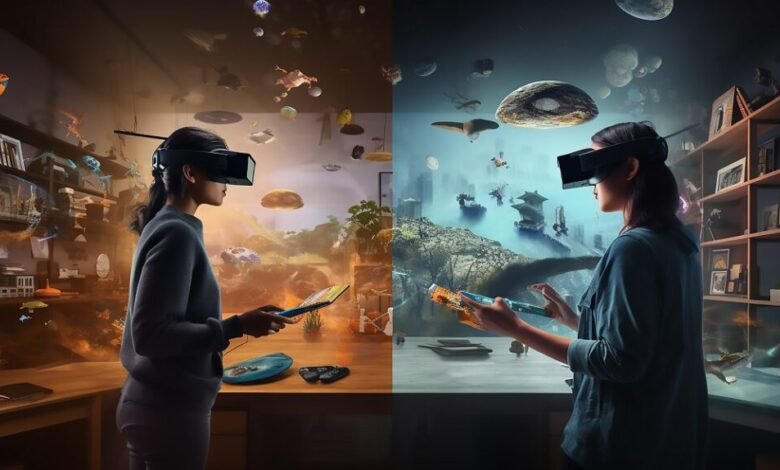The Metaverse Reimagined: Where Virtual Reality Meets Real Business

As the Metaverse evolves, its integration with real business practices presents both opportunities and complexities that warrant careful examination. Companies are exploring how immersive virtual environments can revolutionize customer engagement, enhance collaboration, and redefine marketing strategies. Yet, the promise of this digital frontier is accompanied by significant challenges, particularly concerning privacy and accessibility. Understanding these dynamics is essential for businesses looking to thrive in this innovative landscape. What strategies will ultimately determine success in this reimagined ecosystem?
Defining the Metaverse Landscape
As the digital world continues to evolve, defining the metaverse landscape becomes increasingly essential to understanding its potential impact on society and technology.
This immersive realm encompasses virtual ecosystems and digital economies, where user-generated content fosters social connectivity and collaborative environments.
Through spatial computing and augmented realities, individuals engage with avatar identities, while blockchain integration ensures secure transactions, enhancing the metaverse’s transformative capabilities.
The Evolution of Virtual Reality
The journey of virtual reality has been marked by significant historical milestones that have shaped its development, from early experiments in the 1960s to the immersive experiences of today.
Key technological advancements, including improved hardware and software capabilities, have propelled VR into mainstream consciousness, transforming how we interact with digital environments.
As we look ahead, emerging trends suggest a future where virtual reality becomes increasingly integrated into various aspects of daily life, further blurring the lines between the physical and digital realms.
Historical Milestones in VR
Virtual reality (VR) has undergone a remarkable transformation since its inception, marked by key milestones that have shaped its trajectory.
Historical breakthroughs, driven by virtual pioneers, laid the foundation for immersive experiences. From the development of the Sensorama in the 1960s to the introduction of affordable headsets in the 2010s, each advancement has expanded the possibilities of virtual environments, fostering innovation across various industries.
Key Technological Advancements
How have technological advancements revolutionized the realm of virtual reality?
Innovations such as AI advancements and augmented reality have enhanced immersive storytelling, while cloud rendering and haptic feedback create engaging experiences.
Blockchain integration secures user generated content, and spatial computing allows for the creation of digital twins.
Improved networking protocols further facilitate seamless interactions, positioning virtual reality as a pivotal player in modern business landscapes.
Future Trends in VR
As immersive technologies continue to evolve, the future of virtual reality (VR) promises groundbreaking transformations that will redefine user experiences.
We can expect advancements in mixed reality, enhancing social interaction and fueling the digital economy.
Innovations in immersive education, virtual commerce, and health applications will flourish, while gaming evolution and user-generated content thrive on blockchain integration, ensuring greater accessibility and innovation for all.
Business Applications of the Metaverse
The Metaverse presents transformative opportunities for businesses, particularly through virtual collaboration spaces and immersive marketing experiences.
These digital environments enable teams to collaborate seamlessly, regardless of geographical barriers, while also allowing brands to engage consumers in innovative and memorable ways.
As companies increasingly recognize the potential of the Metaverse, understanding its applications will be crucial for staying competitive in a rapidly evolving market.
Virtual Collaboration Spaces
What if the future of teamwork transcended physical boundaries, allowing colleagues to collaborate seamlessly in immersive digital environments?
Virtual collaboration spaces enable enhanced remote engagement through interactive workshops and immersive brainstorming. These platforms foster team bonding, promote digital networking, and facilitate shared experiences during virtual conferences, ultimately transforming online collaboration into dynamic collaborative environments.
- Enhanced virtual teamwork
- Immersive brainstorming sessions
- Interactive workshops
- Digital networking opportunities
- Virtual conferences for team bonding
Immersive Marketing Experiences
How can brands leverage the immersive capabilities of the metaverse to create unforgettable marketing experiences?
By utilizing immersive storytelling and interactive brand experiences, companies can host virtual product launches and augmented reality campaigns that foster sensory engagement.
Gamified marketing and experiential advertising enhance digital consumer engagement, transforming traditional marketing into dynamic experiences that captivate audiences and elevate brand loyalty in this evolving digital landscape.
Enhancing Customer Experience
As businesses increasingly embrace the metaverse, the opportunity to enhance customer experience becomes paramount.
By focusing on user-centric design, companies can create personalized interactions that resonate emotionally.
Utilizing immersive storytelling and virtual touchpoints, brands can enrich the customer journey through sensory experiences and feedback loops.
- Personalized interactions
- Immersive storytelling
- Emotional engagement
- Feedback loops
- Virtual touchpoints
Remote Collaboration in Virtual Spaces
The rise of remote collaboration in virtual spaces has transformed the way teams interact and innovate, breaking down geographical barriers and fostering a more inclusive work environment.
Virtual teamwork thrives on collaborative platforms, enabling immersive meetings and enhancing remote engagement.
These digital workplaces promote social presence, facilitate interactive brainstorming, and offer creative spaces for virtual networking, ultimately strengthening team building and collaboration across diverse teams.
Marketing Strategies in the Metaverse
What innovative approaches can brands adopt to effectively engage consumers in the Metaverse? Embracing advanced marketing strategies is essential for brand engagement and enhancing digital presence.
Successful brands utilize:
- Experiential marketing through virtual storefronts
- Audience interaction via gamified experiences
- Influencer partnerships for authentic connections
- Social commerce to drive conversions
- Data analytics to tailor community building efforts
These strategies foster deeper consumer relationships and elevate brand visibility.
Challenges and Limitations
While the potential of the Metaverse is vast, brands face significant challenges and limitations when attempting to navigate this complex digital landscape.
User privacy concerns, technical barriers, and hardware limitations hinder robust user engagement.
Additionally, the digital divide exacerbates accessibility issues, while content moderation and security concerns pose further regulatory challenges, complicating the path for brands seeking to thrive in this evolving environment.
Future Trends to Watch
As brands grapple with the challenges and limitations of the Metaverse, emerging trends offer a glimpse into the future of this digital frontier.
Key developments to watch include:
- Enhanced user experience through immersive storytelling
- Evolution of digital identity and economic models
- Greater platform interoperability for seamless social interaction
- Innovations in content creation and user engagement
- Establishment of virtual governance and augmented reality features
Getting Started in the Metaverse
How can individuals and businesses effectively navigate the Metaverse’s vast landscape?
Embrace immersive onboarding experiences to acclimate to new virtual environments and tools.
Engage in virtual networking to forge valuable connections and build partnerships.
Conclusion
In conclusion, the Metaverse stands as a vibrant tapestry where virtual reality interweaves with real business, crafting a new frontier of opportunity. As companies embark on this digital odyssey, they must navigate the intricate dance of innovation while addressing challenges that loom like shadows. The future promises a kaleidoscope of possibilities, where immersive experiences and collaborative ventures flourish. Embracing this evolving landscape will be essential for organizations seeking to thrive in an interconnected, virtual world.




